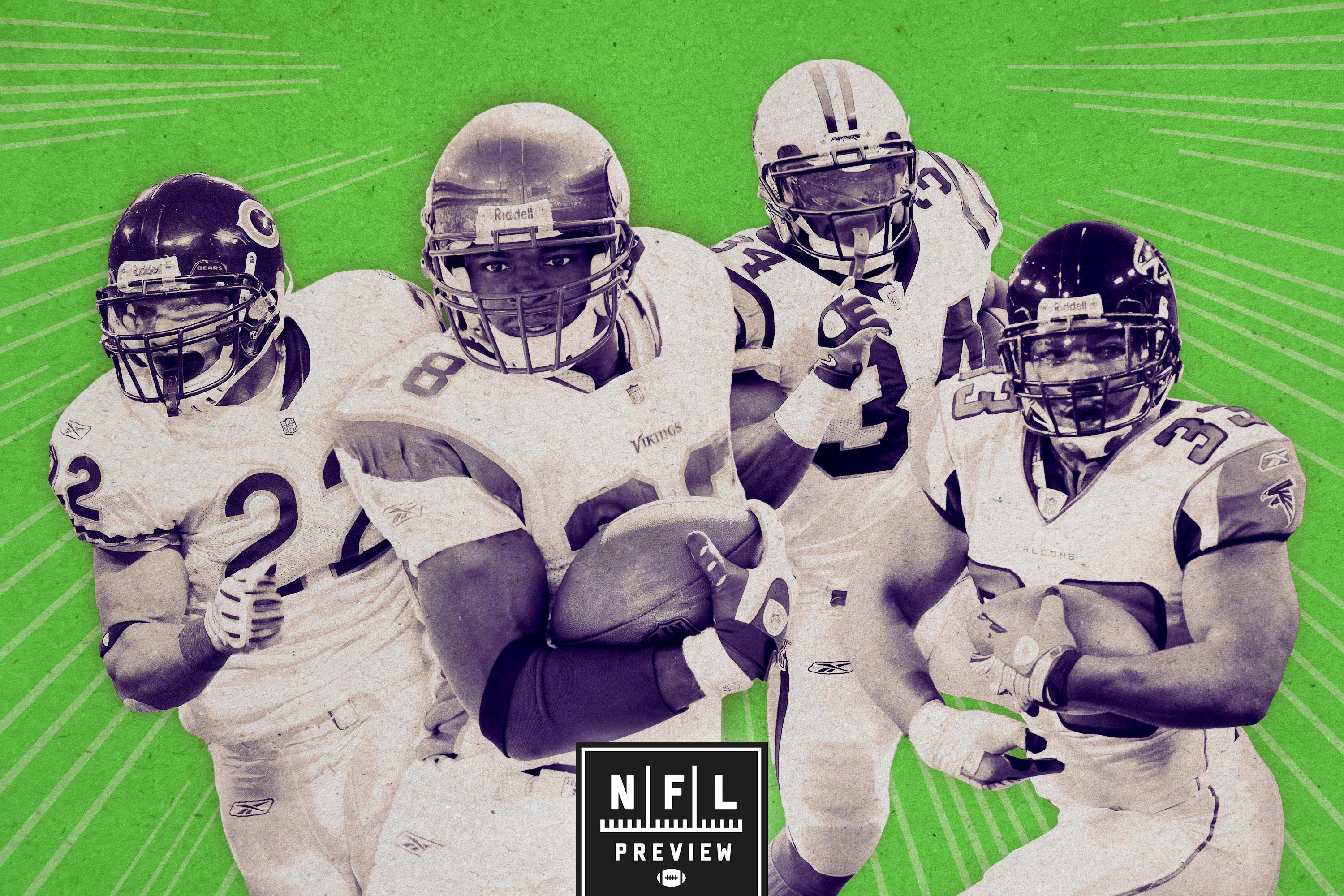
In football years, one decade might as well be a century. Ten years ago, the wildcat ripped the league in half, Aaron Rodgers made his first start for the Packers, Brett Favre played 16 games for the Jets, the Patriots missed the playoffs, and most shocking of all, Jeff Fisher coached a team that won—you’re really not gonna believe this—13 whole games. If you don’t know where you’ve come from, then you don’t know where you’re going. So, to better understand what’s ahead in 2018, we’re spending this week looking back on what happened 10 years before. Welcome to 2008 Week!
Saying the NFL is a copycat league is beyond cliché at this point. We’ve heard it so many times and for so long that it’s become an unquestioned truism: Bad teams steal concepts from the good, and innovations, trends, or even the smallest tweaks that can provide a competitive advantage catch on with everyone in between. Here’s the thing about all that copycatting, though—it doesn’t always happen overnight.
Going into the 2008 season, it would’ve been easy to imagine the league making a quantum leap in the passing game. The Patriots had just posted a near-perfect season on the back of an aerial approach, eschewing the run in favor of an all-out passing attack that featured a no-huddle, breakneck pace, three-, four-, and five-receiver sets, and more shotgun looks than the NFL had ever seen. No one, save for the Super Bowl–winning Giants, seemed to have an answer: Tom Brady threw a then-record 50 touchdown passes and won MVP honors; Randy Moss caught 23 scores, still the record for a single season; and Wes Welker reeled in an NFL-high 112 passes running routes out of the slot. That Patriots squad changed football forever; as Panthers head coach Ron Rivera told my Ringer colleague Kevin Clark last year, “They forced us to where we are today as a league.”
Forced is the perfect word for it, because while that spacing-based, pass-heavy offense New England modeled in 2007 has become the new norm for the league today, teams didn’t buy into those groundbreaking strategies immediately. In fact, that 2008 season would, somewhat counterintuitively, become the pinnacle year for NFL ground attacks this century.
That April’s NFL draft foreshadowed the season to come: Five running backs were taken in the first round—the most at that position since 2000 and in the years since. The Raiders used the fourth overall pick on Darren McFadden; the Panthers chose Jonathan Stewart with no. 13; the Cowboys took Felix Jones with no. 22; the Steelers picked Rashard Mendenhall with no. 23; and the Titans took Chris Johnson with the 24th overall pick. In subsequent rounds, teams jumped on future standouts like Matt Forte (no. 44); Ray Rice (no. 55); Jamaal Charles (no. 73); Tim Hightower (no. 149); Peyton Hillis (no. 227); and Justin Forsett (no. 233). That talented group of rookies made an early impact, and with a burgeoning cadre of second-year pros in Adrian Peterson, Marshawn Lynch, and Ryan Grant—plus a handful of savvy veteran runners like LaDainian Tomlinson, Clinton Portis, and Thomas Jones—the NFL ground game had a season in the sun.
Teams threw the ball less in 2008 than they had the year prior, attempting 519 fewer passes while connecting on 74 fewer touchdown throws. They ran the ball 44.5 percent of the time, a full percentage point higher than the previous year and a higher rate than the league’s seen in any season since. (Note: This figure includes quarterback scrambles as rushes.)
Dropbacks vs. Rush Attempts Since 2000
It didn’t help that the reigning MVP tore his ACL in the opener, but a Brady-less Patriots squad alone wasn’t enough to account for the league’s shockingly resurgent ground game. Runners carried the ball 133 times more than the year before, boosting NFL-wide totals on the ground by 2,580 yards and 90 touchdowns. In all, ball carriers totaled 14,119 total rushes in 2008—more than any season in the past decade—and racked up 476 scores, easily the most of any season this century and the high mark since 1979.
Rushing Numbers Since 2000
What could explain this massive uptick in running? Some of it was born of necessity. While some teams may have loved to adopt the Patriots’ high-flying scheme, not all of them had future Hall of Fame–caliber quarterbacks capable of running it. For those squads lacking an elite signal-caller and/or pass catchers, the run game wasn’t just a preference: Take the Dolphins, who threw caution to the wind and just about abandoned the quarterback position and starter Chad Pennington altogether. Using their Week 3 game in New England (because, of course) as a jump-off point, Miami introduced the NFL to the wildcat offense and rode that confounding new scheme to an 11-5 record, an AFC East title, and a playoff berth. Leading the way were the team’s two running backs—31-year-old veteran Ricky Williams and Pro Bowler Ronnie Brown, the latter of whom finished the year with 916 yards and 10 touchdowns.
The Dolphins weren’t the only team to use their run game as a crutch for bad quarterback play. The Vikings made the playoffs with the combination of Gus Frerotte and Tarvaris Jackson under center, buoyed on offense by Peterson’s 10 touchdowns and league-high 1,760 rushing yards.
With Jake Delhomme (who threw 15 touchdowns and 12 interceptions and finished with an 84.7 passer rating) at the helm, Carolina finished 12-4 and won the NFC South on the strength of its defense and ground game. The Panthers were third in rush yards (2,437) and first in rushing touchdowns (30) that season, and were led by DeAngelo Williams and Stewart, who combined for 2,351 yards and 28 touchdowns. Williams’s 18 touchdowns led the league.
The Falcons, meanwhile, won 11 games and went to the playoffs in Matt Ryan’s rookie year largely because of the foundation Michael Turner laid in the rushing attack. Turner—who signed to a six-year, $34.5 million deal in free agency after spending his first four years as a backup to Tomlinson in San Diego—broke out, and finished with an NFL-high 376 carries, 1,699 yards (second), and 17 scores (second).
Eli Manning and the defending champion Giants rode Derrick Ward and Brandon Jacobs back to the postseason, finishing 12-4 after leading the league in rushing (2,518 yards) and yards per carry (5.0). At 6-foot-4 and 265 pounds, Jacobs rumbled and tumbled for 15 touchdowns, one of an incredible 12 backs to hit double-digits in that category that year (tied for the most this century).
Hell, the 2008 season even seemed to validate Jeff Fisher’s legendarily rigid vision for how to win in the NFL. With 36-year-old quarterback Kerry Collins (who completed 58 percent of his passes and finished the year with 12 touchdowns and seven picks) under center, that Titans squad leaned into their run game, racking up 508 carries (fifth) for 2,199 yards (seventh) and 24 scores (second) on the ground. LenDale White served as the team’s short-yardage and goal-line back, collecting 773 yards and 15 touchdowns on 200 totes, while the rookie Johnson ran all over the competition, rushing for 1,228 yards and nine scores.
Fast-forward to present day, though, and it’s clear that while the 2008 season was a banner year for rushing attacks around the league, it also represented a turning point for modern NFL offenses. Fisher-coached teams make for a nice example, as he’d finish no better than .500 in each of the next seven seasons with the Titans and Rams, in large part due to a dogged adherence to his old-school methodology. As the importance—and efficiency—of passing exploded, Fisher failed to adapt. On the other hand, his replacement in L.A., Sean McVay, quickly installed a few core tenets of that 2007 Patriots’ squad, ditching Fisher’s archaic run-first identity, speeding things up and spreading things out while lining up in now-ubiquitous three-receiver sets on a league-high 81 percent of plays.
L.A. went from last in the league in scoring under Fisher in 2016 to first under McVay in 2017. But while the Rams managed to modernize their offense seemingly overnight, they were undeniably late to the party. In the past decade, other clubs adopted concepts that the Patriots showed off in 2007, tinkering more with shotgun looks, slot receivers, and movable tight ends. Play-calling gradually became more aggressive. With more variety of plays and space with which to throw, quarterbacks became more efficient, and a handful of rules changes—greater protections for quarterbacks from low hits (the same type of hit that caused Brady’s ACL tear) and new rules shielding defenseless receivers in the middle of the field—gave offenses a distinct advantage in the passing game. Play-callers began to realize that more passing led to more scoring. The analytics tell a convincing story: As FiveThirtyEight’s Benjamin Morris put it last May, “There is pretty much no ordinary [neutral] situation in which running produces better results than passing.”
With a boom in passing came a drop in production on the ground, and running back rushing numbers gradually declined in the years following 2008. Despite the explosion in the league’s salary cap, the average size of the most expensive running back contracts leveled off and, in recent years, even decreased, and coming out of the 2017 season, running back was among the lowest-paid positions in the sport, just ahead of special teams and tight end. One-dimensional veteran backs became expendable, with teams simply relying on cheap, first-contract draft picks to carry the load on the ground instead.
But while big-money second contracts have been few and far between for running backs over the past few years, the true difference-makers at the position haven’t become irrelevant. In fact, the running back position may be due for a return to a level of prominence it hasn’t enjoyed since its heyday in the late 2000s—just, in a wholly different way. The Rams’ decision to sign star playmaker Todd Gurley to a four-year, $57.5 million contract extension reflects what they believe is his real value in that team’s offense, not just as a runner, but as a de facto receiver out of the backfield. Gurley, who boasts soft hands, open-field elusiveness, and savvy route-running skills, may be just the first of a growing list of dual-threat running backs of his ilk—players like Le’Veon Bell, David Johnson, Ezekiel Elliott, and Tevin Coleman—to receive a big-money extension.
The evolution of the pro game continues, and while some teams—like the Jaguars, for instance—may look to zig while the rest of the league zags, exploiting the smaller defenders and lighter boxes that the modern air attack has produced, passing remains, indisputably, king. (And the league’s rules changes this offseason should only stimulate more of it.) But that doesn’t mean running backs must look back at the 2008 season only with nostalgia, as the glory days of an increasingly obsolete position—unless, that is, they’re hoping to turn in a Turneresque season, replete with 376 totes and six catches. Instead, as the lines continue to blur between pass catcher and runner, three-down backs who can break tackles on the ground and create mismatches through the air may still be underutilized. Players like that—Alvin Kamara, Saquon Barkley, Christian McCaffrey, and Kareem Hunt—give running backs a chance for a modern revival.


